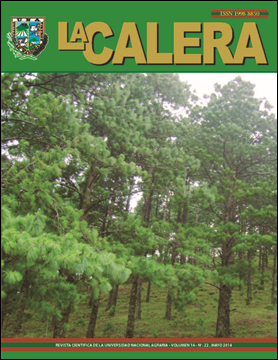Puntos críticos del manejo poscosecha de cacao en Waslala, Nicaragua
DOI:
https://doi.org/10.5377/calera.v14i22.2650Palabras clave:
acopio centralizado, participación familiar, punto de equilibrio, Theobroma cacao L.Resumen
En el período de enero a junio del 2009 se indagó el benefi ciado de cacao en 49 fi ncas de productores socios de la cooperativa CACAONICA en el municipio de Waslala, Nicaragua. El propósito del estudio fue generar información de los costos, tiempos y puntos críticos del benefi ciado en las fi ncas, y realizar un análisis FODA sobre la factibilidad de implementar el modelo de acopio de cacao en baba en dos centros comunitarios. Se aplicaron encuestas a productores y entrevistas semi-estructuradas al equipo técnico de CACAONICA y otros informantes claves vinculados con la comercialización local del cacao. Se elaboró una matriz clasifi cándose la información en relación a las variables tiempo, área de siembra, rendimientos y participación de la familia en la labores poscosecha del cacao. Todas las fi ncas visitadas poseen certifi cación orgánica. Treinta de los productores poseen áreas pequeñas de cacao (aproximadamente de una ha) y 19 cultivan entre 1.5 a siete ha. El benefi ciado de cacao en la fi nca se compone de tres etapas y seis actividades: etapa 1 (cosecha y extracción-selección de semillas), etapa 2 (fermentación y secado) y etapa 3 (empacado y transporte). El proceso de benefi ciado se constituye de 21.7 días calendarios, sin embargo, el tiempo real requerido en días hombre resultó ser 9.14, con un costo de USD 40.33 para benefi ciar 45.45 kg de cacao (un qq ). La etapa 1 resultó ser la más costosa del proceso de benefi ciado (USD 30.13 por cada 45.45 kg). Los puntos críticos que afectan la calidad del benefi ciado del grano son: fermentación (41%) y secado (31%). El punto de equilibrio del benefi ciado en fi nca es 361.8 kg ha-1 ciclo-1. Rendimientos por debajo de este umbral signifi can que el cacaotal no retribuye los costos invertidos por el agricultor. La participación de la familia en el benefi ciado del cacao es relevante, especial atención requiere la participación de la mujer. La gran mayoría de los productores (69%) perciben como buena estrategia implementar el acopio de cacao en baba en benefi cios centralizados, y ratifi caron su participación siempre y cuando el pago sea contra entrega del grano (USD 48.87 por cada 45.45 kg). El éxito del nuevo sistema de acopio dependerá de la gestión de capital para el acondicionamiento de la instalación, la compra del grano a los productores, la definición de rutas lógicas de acopio en las comunidades, el equipamiento básico y la capacitación oportuna al personal técnico responsable de los centros de acopio.
La Calera, Vol. 14. Nº 22, p. 5-12 / mayo 2014
Descargas
1757

